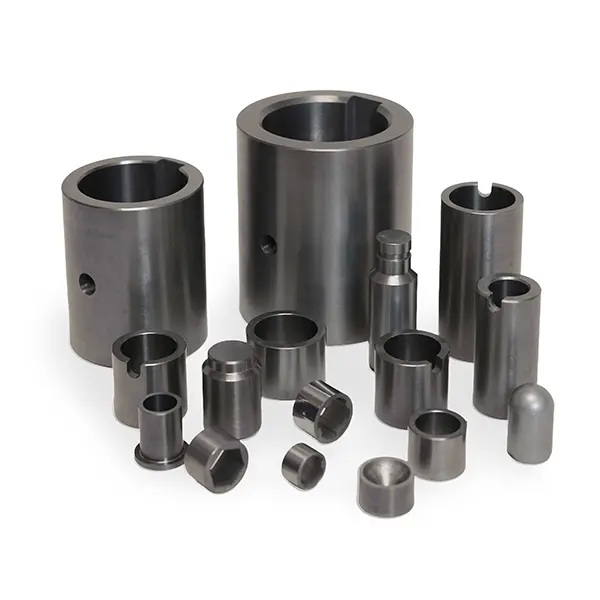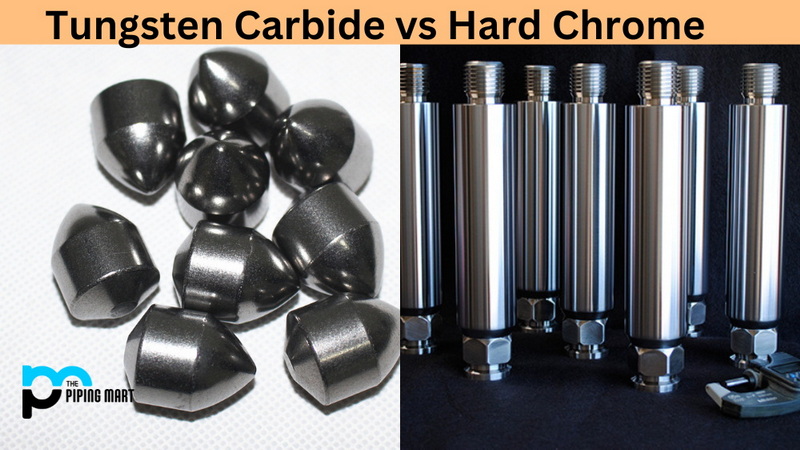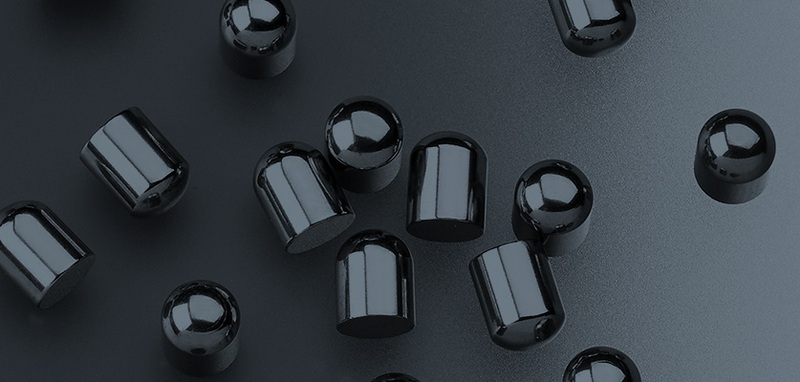Content Menu
● What is Tungsten Carbide?
>> Properties of Tungsten Carbide
>> Applications of Tungsten Carbide
● Electroplating Tungsten Carbide
>> Methods for Electroplating Tungsten Carbide
>> Steps Involved in Electroplating Tungsten Carbide
● Benefits of Electroplating Tungsten Carbide
● Applications of Electroplated Tungsten Carbide
● Alternatives to Electroplating
● Comparison of Coating Methods
● Recent Advances in Tungsten Carbide Coating Technology
● Health and Safety Considerations
● Conclusion
● FAQ
>> 1. Can tungsten carbide be electroplated with pure tungsten?
>> 2. What are the primary benefits of electroplating tungsten carbide?
>> 3. What is electroless nickel plating and why is it used on tungsten carbide?
>> 4. What industries benefit most from using electroplated tungsten carbide?
>> 5. What are the alternatives to electroplating tungsten carbide?
● Citations:
Tungsten carbide is a versatile material known for its exceptional hardness, wear resistance, and thermal properties, making it essential for numerous industrial applications[5]. Often employed in wear applications with service temperatures below 500 degrees Celsius, it is ideal for scenarios requiring resistance to erosion, abrasion, fretting, sliding wear, and impact[2].
Electroplating is a metal finishing technique where an electric current reduces dissolved metal ions to form a metal coating on an electrode[4]. This process, also known as electrodeposition, involves submerging a workpiece (substrate) into a specially formulated electrolyte solution (plating bath)[4].
Due to tungsten's high reactivity, electroplating a substrate with pure tungsten is challenging, typically requiring co-deposition with nickel or other metals[4]. Traditional aqueous plating baths have not yielded acceptable results for tungsten plating[4]. However, plating onto tungsten surfaces, especially tungsten carbide workpieces, is achievable with effective techniques, often enhancing corrosion protection[4].

What is Tungsten Carbide?
Tungsten carbide is a compound of tungsten and carbon. It is an extremely hard material, about three times stiffer than steel, with a Young's modulus of approximately 530–700 GPa, and is twice as dense as steel—nearly midway between lead and gold[5]. It has a high melting point of 2,870 °C (5,200 °F) and a boiling point of 6,000 °C (10,830 °F)[5].
Properties of Tungsten Carbide
Tungsten carbide possesses a unique combination of properties that make it invaluable in various industries[5]:
- Hardness: Exceptionally hard, providing excellent wear resistance[5].
- Wear Resistance: Able to withstand high levels of wear, including erosion, abrasion, and impact[2].
- Thermal Stability: Maintains strength and integrity under severe stress and erosive conditions[5].
- Corrosion Resistance: Offers excellent resistance to oxidation due to strong bond strength and low porosity[2].
- High Melting Point: Can withstand high temperatures without deformation[5].
Applications of Tungsten Carbide
Tungsten carbide's properties make it suitable for a wide array of applications across various industries[5]:
- Aerospace and Aviation: Protects critical engine components like turbine blades and landing gear components from wear[5].
- Oil and Gas Production: Used in drilling equipment to extend the life of drill bits and pump components in abrasive environments[5].
- Manufacturing and Industrial Processing: Applied to cutting tools to extend service life in high-speed machining operations[5].
- Power Generation: Shields turbine components from erosion in conventional and renewable energy systems[5].
- Automotive Industry: Used in the production of heavy metal alloys like high-speed steel for various automotive parts[8].
- Sports Equipment: Utilized in athletic gear like golf clubs due to its durability[7].
Electroplating Tungsten Carbide
Electroplating tungsten carbide involves coating the material with another metal to enhance its properties, such as corrosion resistance, or to prepare it for specific applications[8]. While pure tungsten is difficult to plate, tungsten carbide can be effectively electroplated using specific techniques[4].
Methods for Electroplating Tungsten Carbide
1. Electrolytic Process:
- This method involves electrolyzing tungsten carbide anodes in an aqueous acid fluoride bath to produce available tungsten ions[1]. An acid-soluble salt of a metal (e.g., nickel) is added to alloy with the tungsten. The pH of the bath is adjusted to between 4.5 and 6.8, and the solution is maintained at a temperature between 35°C and 80°C with a current density of about 14 amperes per square foot[1].
- A variation of this process includes dissolving tungsten dioxide (WO2) in an aqueous acid fluoride bath to produce available tungsten ions[1].
2. Electroless Nickel Plating:
- Electroless nickel plating is frequently used on tungsten carbide because it doesn't require an electric current[8]. The process involves immersing the component in a specialized solution where chemical reactions cause the nickel to bind to the substrate[8]. This method provides a uniform coating and enhances corrosion resistance[8].
Steps Involved in Electroplating Tungsten Carbide
1. Preparation of the Tungsten Carbide Substrate:
- The surface must be thoroughly cleaned to remove any contaminants such as oil, grease, or oxides. Methods include ultrasonic cleaning, alkaline cleaning, and acid etching[4].
- Surface Activation: Etching the surface with a suitable etchant improves adhesion of the plated metal.
2. Preparation of the Electrolyte Solution:
- For electrolytic plating, an aqueous acid fluoride bath is prepared. This bath contains tungsten ions, an acid-soluble salt of the metal to be alloyed (e.g., nickel chloride), and other additives to improve plating quality[1].
- For electroless plating, a specialized electroless nickel plating solution is used[8]. This solution contains nickel ions, a reducing agent (e.g., sodium hypophosphite), complexing agents, and stabilizers[8].
3. Electroplating Process:
- Electrolytic Plating: The tungsten carbide substrate is placed in the electrolyte bath as the cathode, and a tungsten or tungsten alloy anode is used. A current is applied, causing the metal ions in the solution to deposit onto the tungsten carbide surface[1].
- Electroless Plating: The tungsten carbide substrate is immersed in the electroless plating bath. The solution is heated to the appropriate temperature (typically between 80-90°C), and the chemical reactions cause the nickel to deposit onto the substrate[8].
4. Post-Treatment:
- After plating, the component is rinsed thoroughly to remove any residual electrolyte solution[4].
- A post-coating embrittlement relief process may be applied to ensure sufficient, long-lasting coating adhesion[4].
- The coating may be subjected to heat treatment to improve its hardness and adhesion[2].

Benefits of Electroplating Tungsten Carbide
Electroplating tungsten carbide offers several advantages[8]:
- Enhanced Corrosion Resistance: The plated layer protects the tungsten carbide from corrosive environments[8].
- Improved Wear Resistance: The coating can provide additional wear resistance, depending on the metal used[2].
- Increased Surface Hardness: Certain coatings, such as nickel, can increase the surface hardness of the tungsten carbide[2].
- Better Electrical Conductivity: Coatings like nickel improve electrical conductivity, which is beneficial in electronic applications[8].
- Facilitated Welding and Soldering: Nickel coatings make it easier to perform welding, soldering, and brazing on the surface[8].
Applications of Electroplated Tungsten Carbide
Electroplated tungsten carbide is used in a variety of applications due to its enhanced properties[5]:
- Cutting Tools: Tungsten carbide is commonly used in the production of cutting, turning, and milling tools for the petroleum, mining, metalworking, and woodworking industries[8]. Electroplating enhances the tool's wear and corrosion resistance[5].
- Electronic Components: Due to tungsten's electrical conductivity and heat resistance, it is used in electrical contacts, semiconductors, and heat sinks. Nickel coatings improve corrosion resistance and enable more even coating[8].
- Industrial Equipment: In components such as heating elements and radiation shields, electroplating enhances the material's resistance to harsh environments[5].
- Automotive and Aerospace Components: Used in parts that require resistance to heat, wear, and corrosion, such as those found in automotive and aerospace applications[8].
- Hydraulic Pistons: Enhances the wear and corrosive resistance in hydraulic systems[2].
- Drill Bits: Extends the life and performance of drilling equipment in various industries[2].
- Aerospace Engines: Protects engine components from wear and environmental factors[2].
- Gate and Ball Valves: Improves the durability and reliability of valve components[2].
- Down Hole Tools: Ensures the longevity of tools used in oil and gas extraction[2].
- Airplane Landing Trunnions: Provides wear and corrosion protection for critical landing gear components[2].
- Pump Applications: Enhances the performance and lifespan of pump components[2].
Alternatives to Electroplating
While electroplating is a common method for enhancing the properties of tungsten carbide, other coating techniques offer distinct advantages[2]:
- High-Velocity Oxygen Fuel (HVOF) Coating: This thermal spray process combines tungsten and cobalt, resulting in a coating with high bond strength, low porosity, and excellent wear resistance[6]. HVOF coatings are denser and better bonded than those from air plasma or combustion powder spray processes and are often used as a replacement for hard chrome plating[2].
- Plasma Spray Coating: Involves spraying molten or heat-softened materials onto a surface to provide a coating. This method can be used with a variety of materials and is suitable for large surface areas[6].
- Chemical Vapor Deposition (CVD): A process in which a thin film is deposited onto a substrate through a chemical reaction of vaporized precursors. CVD coatings are known for their uniformity and strong adhesion[2].
- Physical Vapor Deposition (PVD): A vacuum coating technique used to produce thin films and coatings. PVD processes include sputtering, evaporation, and arc vapor deposition[2].
Comparison of Coating Methods
| Coating Method | Process | Advantages | Disadvantages | Applications |
| Electroplating | Uses electric current to reduce dissolved metal ions and form a coating on an electrode[4]. | Enhanced corrosion resistance, improved wear resistance, increased surface hardness, better electrical conductivity, facilitated welding and soldering[8]. | Can be challenging with pure tungsten, requires specific bath chemistry, may need post-treatment for optimal adhesion[4]. | Cutting tools, electronic components, industrial equipment, automotive and aerospace components[8]. |
| HVOF Coating | Sprays a combination of tungsten and cobalt onto the substrate using high-velocity oxygen fuel[6]. | High bond strength, low porosity, excellent wear resistance, superior hardness and corrosive resistance compared to hard chrome plating[2]. | Higher service temperatures can result in brittle phases that reduce wear resistance and coating integrity, not recommended for strong acids[2]. | Hydraulic pistons, drill bits, aerospace engines, gate and ball valves, down hole tools, airplane landing trunnions, various pump applications[2]. |
| Plasma Spray Coating | Sprays molten or heat-softened materials onto a surface[6]. | Versatile, can be used with a variety of materials, suitable for large surface areas[6]. | Can have higher porosity compared to HVOF, may require post-treatment[6]. | Wear-resistant coatings, thermal barrier coatings, corrosion-resistant coatings[6]. |
| Chemical Vapor Deposition (CVD) | Deposits a thin film onto a substrate through a chemical reaction of vaporized precursors[2]. | Uniform coating, strong adhesion, good for high-temperature applications[2]. | Can be expensive, requires high temperatures, may produce hazardous byproducts[2]. | Semiconductor manufacturing, wear-resistant coatings, corrosion-resistant coatings[2]. |
| Physical Vapor Deposition (PVD) | Vacuum coating technique used to produce thin films and coatings[2]. | High hardness, wear resistance, corrosion resistance, can be used with a variety of materials[2]. | Can be expensive, limited coating thickness, may require post-treatment[2]. | Cutting tools, decorative coatings, wear-resistant coatings[2]. |
Recent Advances in Tungsten Carbide Coating Technology
Recent research has focused on enhancing the performance and application of tungsten carbide coatings[5]:
- Nanostructured Tungsten Carbide Coatings: These coatings offer improved hardness, wear resistance, and fracture toughness due to their refined microstructure.
- Hybrid Coatings: Combining tungsten carbide with other materials, such as graphene or polymers, can create coatings with tailored properties, such as enhanced corrosion resistance or reduced friction.
- Advanced Deposition Techniques: Techniques like pulsed laser deposition (PLD) and high-power impulse magnetron sputtering (HiPIMS) allow for the creation of denser and more uniform coatings with improved adhesion.
- Surface Modification: Pre- and post-treatment surface modifications, such as plasma treatment or laser surface texturing, can further enhance the performance of tungsten carbide coatings.
Health and Safety Considerations
When working with tungsten carbide and electroplating processes, it is important to consider potential health and safety risks[2]:
- Hexavalent Chromium: Traditional hard chrome plating, now heavily restricted under the REACH directive, utilizes hexavalent chromium, a known human carcinogen[2]. HVOF-applied tungsten carbide coatings are considered a safer alternative[2].
- Exposure to Chemicals: Electroplating involves the use of various chemicals, some of which may be hazardous. Proper personal protective equipment (PPE), such as gloves, masks, and eye protection, should be worn[2].
- Ventilation: Adequate ventilation is necessary to minimize exposure to airborne particles and chemical vapors[2].
- Waste Disposal: Proper disposal methods for waste materials and spent electrolyte solutions must be followed to minimize environmental impact[2].
Conclusion
In conclusion, while pure tungsten is difficult to electroplate, tungsten carbide can be effectively electroplated to enhance its properties and expand its applications. The electroplating process, whether electrolytic or electroless, offers benefits such as improved corrosion resistance, wear resistance, and surface hardness. Alternative coating methods like HVOF and plasma spraying provide additional options for achieving specific performance characteristics. As technology advances, ongoing research continues to improve the performance and application of tungsten carbide coatings, ensuring their continued importance across numerous industries. By understanding the properties, processes, and benefits of electroplating tungsten carbide, engineers and manufacturers can make informed decisions to optimize their materials and processes.

FAQ
1. Can tungsten carbide be electroplated with pure tungsten?
While it is challenging to electroplate tungsten carbide with pure tungsten due to tungsten's high reactivity, it is possible to electroplate it with other metals like nickel to enhance its properties such as corrosion resistance and wear resistance[4].
2. What are the primary benefits of electroplating tungsten carbide?
The primary benefits include enhanced corrosion resistance, improved wear resistance, increased surface hardness, better electrical conductivity, and facilitated welding and soldering[8].
3. What is electroless nickel plating and why is it used on tungsten carbide?
Electroless nickel plating is a process that does not require an electric current. It is used on tungsten carbide to provide a uniform coating, improve corrosion resistance, and make it easier to perform welding and soldering on the surface[8].
4. What industries benefit most from using electroplated tungsten carbide?
Industries that benefit most include aerospace, oil and gas, manufacturing, power generation, automotive, and electronics, due to the enhanced wear resistance, corrosion resistance, and thermal stability of the coated material[5][8].
5. What are the alternatives to electroplating tungsten carbide?
Alternatives include High-Velocity Oxygen Fuel (HVOF) coating, plasma spray coating, Chemical Vapor Deposition (CVD), and Physical Vapor Deposition (PVD)[2]. Each method offers distinct advantages and is suitable for different applications[6].
Citations:
[1] https://www.freepatentsonline.com/2145745.html
[2] https://www.bandbprecision.co.uk/tungsten-carbide-coating/
[3] https://www.sciencemadness.org/talk/viewthread.php?tid=77083
[4] https://www.sharrettsplating.com/base-materials/tungsten
[5] https://www.linde-amt.com/resource-library/articles/tungsten-carbide
[6] https://www.industrialplating.com/materials/tungsten-carbide-coatings
[7] https://rselectro.in/blog-description/5-tungsten-carbide-applications/9135
[8] https://www.sharrettsplating.com/blog/electroless-nickel-plating-tungsten/
















